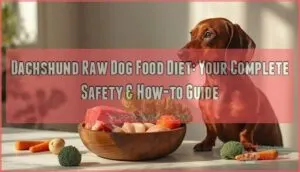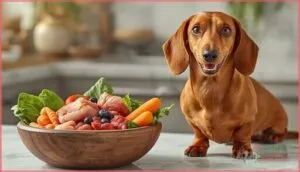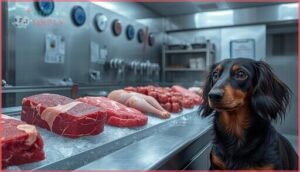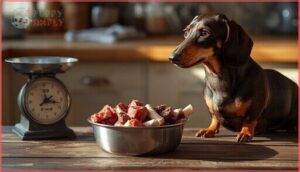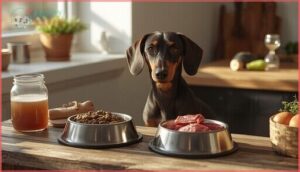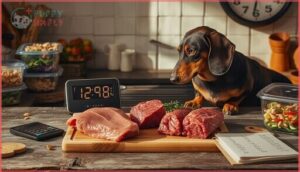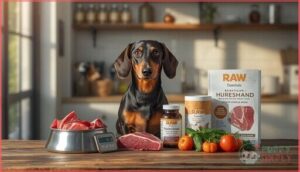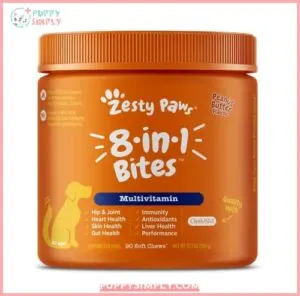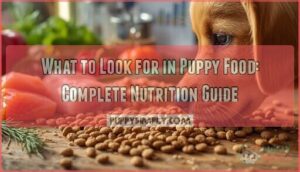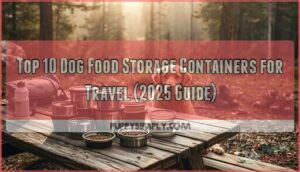This site is supported by our readers. We may earn a commission, at no cost to you, if you purchase through links.
Your dachshund’s wild ancestors didn’t cook their meals, and that simple observation has sparked a growing movement among dog owners who believe raw feeding offers enhanced nutrition. A dachshund raw dog food diet consists of uncooked muscle meat, raw edible bones, organs, and sometimes fruits and vegetables—designed to mirror what canines evolved eating in nature.
Advocates report shinier coats, cleaner teeth, and increased vitality, while skeptics warn about bacterial contamination and nutritional gaps. The truth lies somewhere between these extremes, and making an informed decision requires understanding both the potential benefits and legitimate safety concerns.
This guide breaks down everything you need to know about raw feeding your dachshund, from proper nutrient ratios to safe handling practices.
Table Of Contents
- Key Takeaways
- What is a Raw Dog Food Diet for Dachshunds
- Benefits of a Raw Diet for Dachshunds
- Potential Risks and Safety Concerns
- How to Prepare a Balanced Raw Diet
- Transitioning Your Dachshund to Raw Food
- Cost and Time Considerations of Raw Feeding
- Veterinary Recommendations and Common Concerns
- Top 4 Products for Dachshund Raw Feeding Success
- Frequently Asked Questions (FAQs)
- How to balance raw diets with seasonal allergies?
- Can raw diets affect a Dachshund’s behavior?
- What are the risks of homemade raw diets?
- How to ensure a raw diet is complete for puppies?
- Are there any breed-specific considerations for raw diets?
- Can puppies and senior dachshunds eat raw food?
- How do I store raw dog food safely?
- What are the best freezer-friendly raw food options?
- Should I feed raw on a travel schedule?
- Can raw feeding help with dachshund back problems?
- Conclusion
Key Takeaways
- Raw feeding provides measurable health benefits like 97.5% fat digestibility and faster digestion (4–12 hours versus 12–24 for kibble), but up to 80% of raw diets contain dangerous pathogens like Salmonella that pose serious risks to both dogs and humans.
- Proper raw diet formulation demands precise nutrient ratios—70–80% muscle meat, 10–15% raw edible bones, and 10% organs—because studies show 82% of homemade raw diets lack adequate calcium and 63% fall short on vitamin D, causing bone deformities and metabolic disorders.
- Most veterinary organizations, including the AVMA, actively discourage raw feeding due to bacterial contamination and nutritional imbalances, with 30–40% of gastrointestinal obstructions stemming from bone fragments and treatment costs for foodborne illness ranging from $200 to $2,000 per incident.
- Successfully transitioning to raw feeding requires gradual 10-day dietary shifts, strict food safety protocols, including separate preparation surfaces, and ongoing veterinary monitoring every 6–12 months to catch nutritional gaps before they cause irreversible damage.
What is a Raw Dog Food Diet for Dachshunds
A raw dog food diet for dachshunds means feeding your dog uncooked meat, edible bones, and organs instead of processed kibble or canned food. This approach aims to mimic what dogs’ ancestors ate in the wild, though the specifics vary depending on which feeding philosophy you follow.
Let’s break down the main types of raw diets, what goes into them, and clear up some common misunderstandings you might encounter.
BARF Vs. Prey Model Diets
Two main raw feeding strategies dominate the Dachshund raw diet landscape: BARF (Biologically Appropriate Raw Food) and Prey Model Diet. The raw diet comparison reveals distinct nutrient profiles—BARF combines 70-85% animal ingredients with fruits and vegetables for diet flexibility, while Prey Model follows an 80-10-10 ratio of muscle, bone, and organs exclusively.
Your meat sourcing and feeding strategies will differ markedly between these raw dog food approaches. Understanding the raw feeding methods is vital for a successful shift.
Key Components: Meat, Bones, and Organs
Building on either BARF or Prey Model foundations, you’ll need three core components for Raw Dog Food success.
Muscle meat forms 70-80% of your Dachshund’s Raw Meat intake, delivering protein with digestibility exceeding 95%. Raw edible Bone provides calcium at 10-15% by weight—maintaining a 1.2:1 calcium-phosphorus ratio.
Organ Balance rounds out nutrition: liver supplies vitamin A, while heart and kidney contribute essential cofactors for metabolic function. Understanding the raw food models is essential for a well-planned diet.
Common Misconceptions About Raw Diets
Despite these components forming solid Raw Dog Food foundations, Diet Misconceptions persist. You’ve likely heard raw feeding makes dogs aggressive—behavioral studies disprove this Raw Diet Myth entirely.
Concerns about Pet Nutrition deficiencies apply mainly to unsupervised homemade meals, not properly formulated BARF Diet plans.
Food Safety worries about Raw Meat pathogens are valid, yet High Pressure Processing in commercial Biologically Appropriate Raw Food products greatly reduces bacterial risks when you follow proper Raw Feeding protocols.
Benefits of a Raw Diet for Dachshunds
Raw feeding advocates point to several compelling changes they’ve observed in their dogs—from shinier coats to cleaner teeth. These benefits often drive Dachshund owners to explore this dietary shift despite ongoing debates in the veterinary community.
Let’s examine the most commonly reported improvements and what the evidence actually shows.
Improved Skin, Coat, and Dental Health
Raw feeding can transform your dachshund’s appearance from the outside in. Here’s what raw dog food delivers for canine health:
- Skin nutrition improves through omega-3 fatty acids, reducing irritation and inflammation
- Coat shine intensifies as bioavailable proteins strengthen hair and boost luster
- Dental care happens naturally when raw meaty bones scrape away plaque
- Healthier grooming starts with reduced dryness and flakiness
- Raw benefits include fresher breath and stronger gums
Studies confirm dogs on raw food diets show measurable improvements in skin barrier function and dog nutrition markers.
Enhanced Energy and Digestion
Your dachshund’s vitality depends on efficient meal-to-fuel conversion. Raw dog food accelerates digestion, with dogs processing raw feeding diets in 4–12 hours compared to the sluggish timeline of kibble. Fat digestibility reaches 97.5% on raw diets, while apparent energy digestibility hits 98.4%. These nutrient absorption rates ensure your dachshund extracts maximum canine health benefits from every bite.
Raw dog food delivers 97.5% fat digestibility and processes in 4–12 hours—faster, cleaner fuel conversion than kibble
| Digestive Metric | Raw Dog Food | Commercial Kibble |
|---|---|---|
| Transit Time | 4–12 hours | 12–24 hours |
| Fat Digestibility | 97.5% | 92.1% |
| Energy Absorption | 98.4% | 87.6% |
Digestive enzymes remain intact in uncooked meat, naturally supporting gut health. A dachshund raw diet promotes metabolic balance through lower blood glucose and elevated ketone bodies—energy boosters that sustain stamina without sugar spikes. Smaller, firmer stools confirm enhanced dog nutrition efficiency.
Allergy Relief and Weight Management
Sensitivity to allergy triggers diminishes when your dachshund consumes raw nutrition free from grains and preservatives. Finnish research spanning 16,000 dogs confirms puppies fed 20% raw food show nearly half the environmental allergies compared to kibble-fed peers.
Raw dog food benefits extend to weight control through high-quality proteins that build lean muscle, while the intact immune system resists inflammatory responses.
This dachshund raw diet approach to natural dog food transforms dachshund care and nutrition with measurable dog health benefits.
Potential Risks and Safety Concerns
Raw diets aren’t without their downsides, and you need to understand what you’re dealing with before making the switch. The reality is that feeding uncooked meat and bones comes with legitimate safety concerns that can affect both your dachshund and your household.
Let’s walk through the three main risk categories you should consider carefully.
Pathogen Contamination and Foodborne Illness
Bacterial risks in raw dog food are serious—studies show contamination rates for Salmonella can hit 80% in homemade raw diets. Pathogen transmission doesn’t stop at your dachshund’s bowl.
Consider these raw meat hazards:
- Zoonotic diseases spread to humans, especially kids and immunocompromised family members handling raw feeding prep or waste
- Antibiotic-resistant bacteria shed in feces contaminate your home environment
- Treatment costs for foodborne illness range from $200 to $2,000 per case
Food safety protocols aren’t optional—they’re essential.
Bone Hazards and Choking Risks
Your dachshund’s throat isn’t built for gambles. Raw bone risks include choking hazards and gastrointestinal obstructions—30-40% of all blockages stem from bone fragments. Bone splintering causes esophageal tears and rectal bleeding. Small mouths magnify danger in raw feeding. Weight-bearing bones and ribs pose the highest threat.
Even advocates of the BARF diet acknowledge that raw dog food safety hinges on bone selection and supervision.
Nutritional Imbalances and Deficiencies
You can’t eyeball nutritional balance in a dachshund raw diet. Up to 82% of home-prepared raw food diets for dogs lack adequate calcium, while 63% fall short on vitamin D—triggering bone deformities and metabolic disorders.
Fatty acid gaps, amino acid deficiencies, and mineral shortages compound quickly without expert formulation. Meeting canine nutrition and diet standards for dachshunds’ dietary needs demands precision, not guesswork.
How to Prepare a Balanced Raw Diet
If you’re going to feed raw, you need to know exactly what goes into your dachshund’s bowl—and in what amounts. Getting the proportions right isn’t optional; it’s the difference between a thriving dog and one facing serious nutritional gaps.
Here’s how to build a balanced raw diet that covers all the bases.
Sourcing Quality Ingredients Safely
You can’t feed your Dachshund safely without knowing where your raw meat comes from. Supplier verification and ingredient testing aren’t optional—by 2025, over 40% of North American raw dog food producers use third-party certified suppliers.
Demand cold chain management documentation and pathogen screening results. Look for BARF diet ingredients meeting regulatory compliance standards, as 85% of recalls involve uncertified sources.
Proportion Guidelines for Dachshunds
Once you’ve secured quality ingredients, nail your Dachshund Raw Diet proportions: your pup needs 2-3% of their ideal body weight daily in raw food. For a 9-pound Dachshund, that’s roughly 100 grams.
Split this into 70-80% muscle meat, 10-15% raw edible bones, and 10% organs.
Adjust daily feeding amounts based on activity—active dogs push toward 3%, while couch potatoes stay closer to 2% for weight management.
Including Fruits, Vegetables, and Supplements
Beyond meat and bones, your Dachshund Raw Diet needs 7% vegetables and 1% fruit by weight—think carrots, sweet potato, and blueberries for fiber, antioxidants, and nutrient balance.
Add omega-3 oil and a dog multivitamin to cover vitamin D and E gaps common in raw recipes.
Supplement safety matters: excessive liver causes toxicity, so stick to proven raw feeding ratios and rotate ingredients for complete dietary needs for Dachshunds.
Transitioning Your Dachshund to Raw Food
Switching your dachshund to raw food isn’t something you do overnight. A rushed shift can trigger digestive upset, refused meals, and unnecessary stress for both you and your dog.
Here’s how to make the change gradually, monitor your dachshund’s response, and recognize when the shift is working.
Gradual Diet Changes and Portion Adjustments
Successfully shifting your dachshund to raw feeding requires patience and precision with diet adjustment. Start with small portions—just 1 teaspoon mixed with current food—and follow this proven feeding schedule:
- Days 1-3: 25% raw, 75% old food
- Days 4-6: Equal 50/50 split
- Days 7-10: 75% raw, 25% old food
Adult dachshunds usually need 2-3% of their ideal body weight daily for ideal nutritional balance and portion control.
Monitoring Digestive Health and Stools
Once you’ve adjusted portions, watch your dachshund’s stool quality like a hawk—it’s your best window into gut health and nutrient absorption. Firm, smaller stools signal efficient digestion, while loose ones may indicate too-rapid raw feeding changes.
Raw dog food boosts digestive enzymes naturally, but persistent diarrhea warrants fecal analysis. Track color, smell, and consistency daily to catch issues before they escalate.
Signs of Successful Transition
Your dachshund’s thriving on raw feeding when you see these clear markers:
- Enhanced coat condition – Shinier fur with less dryness appears within weeks, signaling improved digestion and nutrient absorption from raw dog food.
- Better stools – Firmer, smaller elimination indicates your dietary shift is working.
- Increased energy – Greater playfulness and reduced allergies confirm balanced dog diet and nutrition.
Cost and Time Considerations of Raw Feeding
Raw feeding isn’t just a nutritional decision—it’s a financial and logistical commitment that demands honest assessment before you begin. You need to understand both the upfront costs and the time investment required to safely prepare your dachshund’s meals.
Let’s break down what you’re really signing up for so you can make an informed choice that fits your budget and lifestyle.
Homemade Vs. Commercial Raw Diet Costs
When you’re weighing your raw feeding economics, the numbers tell a clear story. Commercial raw dog food typically runs $4.13 to $8.59 daily for your dachshund, while homemade BARF diet costs drop to $3.36–$6.72. That’s roughly $1,000 annually for commercial versus $600–$700 for DIY raw ingredients.
Budget planning becomes essential—sourcing bulk chicken at $1.50 per pound beats premium pre-packaged convenience every time.
Planning and Meal Prep Tips
Efficiency transforms raw food storage and meal planning from chaos into routine. Set aside 1–2 hours every two weeks to pre-portion meals using a digital kitchen scale—this ensures nutrient balance matches your dachshund’s dietary needs for dogs while fitting your feeding schedules.
- Freeze organ meats separately until use to preserve nutrients and maintain kitchen safety
- Thaw raw dog food portions in the refrigerator over 1–2 days to prevent bacterial growth
- Label BARF diet containers with prep dates to rotate stock and consume older meals first
Long-term Health and Veterinary Expenses
Your wallet and your dachshund’s health are tightly linked when raw feeding. While upfront food costs run $2.33–$10 per pound, proper nutritional balance may reduce expenses for allergy treatments and dental cleanings over time. However, mishandled raw dog food increases risks of infections costing $200–$2,000 per incident.
| Cost Factor | Potential Savings | Potential Expenses |
|---|---|---|
| Dental Care | Fewer cleanings from natural tartar control | Emergency treatment for bone injuries |
| Chronic Conditions | Reduced allergy medications and treatments | Correcting nutritional imbalances |
| Foodborne Illness | Prevention through proper handling | $200–$2,000 per infection case |
| Weight Management | Lower obesity-related health costs | Monitoring and blood work expenses |
Raw diet economics demand careful planning—balance pet health and wellness benefits against health risks through expert-formulated meals and regular veterinary monitoring for long-term wellness in canine nutrition and diet.
Veterinary Recommendations and Common Concerns
Most veterinarians don’t recommend raw diets for dachshunds, and their concerns are worth understanding before you commit. The consensus isn’t about dismissing your choices—it’s about protecting your dog from preventable risks that show up in clinical practice regularly.
Here’s what veterinary professionals actually say about raw feeding, how health conditions factor in, and why monitoring becomes non-negotiable.
What Vets Say About Raw Feeding
Most veterinarians won’t sugarcoat it: raw feeding carries serious risks. Major organizations like the AVMA and CVMA discourage raw dog food due to pathogen contamination and nutritional imbalances that can harm your dachshund.
- Up to 80% of raw pet food samples contain Salmonella or harmful bacteria
- Raw diets often lack essential nutrients, causing bone fractures or vitamin toxicities
- Biologically Appropriate Raw Food (BARF diet) increases multidrug-resistant bacteria shedding
- Board-certified veterinary nutritionists prefer cooked or commercial diets for feeding safety
Raw Diets for Dogs With Health Conditions
If your dachshund has existing health issues, raw diets demand extra caution. Raw diet risks multiply when dogs face kidney disease, allergies, or digestive disorders. While biologically appropriate raw food proponents claim benefits, nearly 40% of owners stopped raw feeding due to GI problems. Here’s what you need to know about raw food diets for dogs with specific conditions:
| Health Condition | Raw Diet Consideration | Key Risk Factor |
|---|---|---|
| Kidney Disease | Low sodium raw diets may help | Phosphate additives worsen stress |
| Food Allergies | Grain-free options reduce triggers | Pathogen control becomes critical |
| GI Issues | 80% develop digestive problems | Diarrhea and obstruction risks |
Chronic management requires strict nutrient balance and health monitoring. Dogs with compromised immune systems face heightened pathogen exposure from raw meat—60% to 90% of BARF diet samples exceed safe bacteria thresholds. Your dachshund’s condition dictates whether raw feeding is a gamble you can afford to take.
Regular Health Monitoring and Check-ups
If you’re feeding raw dog food, plan on seeing your vet every 6 to 12 months minimum. Raw feeders visit clinics more often than traditional pet owners—that’s not coincidence.
Regular health checks catch nutritional gaps, pathogen exposure, and early signs of illness before they escalate. Disease prevention starts with wellness tracking.
Your dachshund’s health depends on consistent veterinary care and nutrition planning oversight.
Top 4 Products for Dachshund Raw Feeding Success
You don’t need to navigate raw feeding alone—the right resources and tools can make all the difference between confusion and confidence. Whether you’re just starting out or fine-tuning your approach, these carefully selected products address the most common challenges dachshund owners face.
Here are four practical tools that support safer, more balanced raw feeding for your dog.
1. Raw Feeding Guide For Dogs
 View On Amazon
View On Amazon Shifting to raw feeding can feel overwhelming without solid guidance. Kimberly Gauthier’s Raw Feeding Guide for Dogs offers practical insights into canine nutrition, feeding schedules, and raw diet planning.
At $8.31, you’ll get beginner-friendly explanations of raw food safety and dietary needs. The guide covers raw feeding benefits and dog health monitoring strategies, though some readers found it basic.
While it simplifies raw food diet for dogs concepts effectively, you’ll likely need additional resources for thorough implementation. It’s particularly valuable if you’re just starting your raw feeding journey.
Best For: Dog owners new to raw feeding who want a straightforward introduction to the basics without getting overwhelmed by technical details.
- Simple breakdown of BARF and Prey Model diets that makes choosing between approaches easier for beginners.
- Practical feeding guidelines with specific percentages and portion sizes based on your dog’s weight and age.
- Affordable at $8.31, giving you solid foundational knowledge without a big investment.
- Lacks depth on advanced topics, so experienced raw feeders won’t find much new information.
- May not apply well to European readers due to differences in product availability and sourcing.
- Some content appears recycled from the author’s blog, which might feel repetitive if you’ve already followed her work.
2. Pet Food Safety Guide Magnet
Beyond reading materials, you’ll need practical tools to prevent food contamination. The Pet Food Safety Guide Magnet (8.5″ x 11″) displays toxic and safe foods at a glance, protecting your dachshund from accidental poisoning during raw feeding transitions. This vinyl magnet includes emergency poison control hotlines and household contact lists.
While magnetic separation technology prevents metal contamination in commercial pet food production facilities, this educational chart helps you maintain foodborne prevention standards at home. At under $10, it’s a straightforward investment in pet nutrition safety and natural pet care awareness.
Best For: New pet owners, families with kids, and anyone who wants a quick reference to keep their pets safe from toxic foods.
- Lists toxic and safe foods in one simple chart that’s always visible on your fridge
- Includes emergency poison control numbers so you’re ready if something goes wrong
- Durable vinyl material holds up well and works on any magnetic surface
- The 8.5 x 11 inch size might feel too big for smaller kitchens or crowded fridges
- Only covers common foods, so it won’t list every possible toxic substance
- You’re limited to one magnet and emergency contact sheet per order
3. Zesty Paws Dog Multivitamin Chews
Nutritional gaps can emerge when you’re building homemade raw food diet formulations for your dachshund. Zesty Paws 8-in-1 Multivitamin Chews address this concern with glucosamine for joint support, probiotics for gut health, and omega fatty acids for coat maintenance—filling deficiencies that raw dog food nutrition sometimes misses.
Each soft chew delivers vitamin support through B-complex, vitamin E, and antioxidants that complement natural pet care approaches. For dachshunds under 25 pounds, one daily chew costs roughly $0.30, making this dog supplement a practical health supplements addition to raw feeding protocols without replacing veterinary-formulated dog nutrition plans.
Best For: Dachshund owners feeding homemade raw diets who need a convenient multivitamin to fill nutritional gaps and support joint health, digestion, and coat quality.
- Covers eight health areas in one chew—joint support with glucosamine and chondroitin, gut health with probiotics, and skin/coat maintenance with omega fatty acids and vitamin E.
- Soft chew format with peanut butter flavor makes daily supplementation easy, even for picky eaters or dogs that resist pills.
- Cost-effective at around $0.30 per day for small dachshunds under 25 pounds, with noticeable improvements in coat softness and digestive stability reported within weeks.
- Results for joint mobility may take several weeks to become apparent, requiring patience and consistent daily use.
- Some users report the chews can be crumbly or slightly dry, which may affect handling or storage.
- Pricier than basic single-ingredient supplements, and recent quantity or pricing changes have disappointed some repeat customers.
4. Raw Dog Food Diet Guide
 View On Amazon
View On Amazon Ian Billinghurst’s “Give Your Dog a Bone“ ($27.95) pioneered raw diet planning in 1993, but you’ll need to cross-reference its raw diet benefits against current veterinary guidelines.
This diet guide covers nutrient balance fundamentals, meal prep tips, and safe handling protocols for dachshund raw food diet transitions.
While the book explains dietary rotation and raw dog food philosophy, be aware that some recommendations—like feeding garlic—no longer align with modern veterinary safety standards for safe handling practices.
Best For: Dog owners interested in transitioning their pets to a raw food diet who want foundational knowledge on nutrient ratios, sourcing ingredients, and safe preparation methods.
- Provides detailed proportion guidelines and practical meal prep instructions that help you understand how to balance muscle meat, organs, bones, and vegetables for optimal nutrition.
- Includes comprehensive safe handling practices and transition protocols that minimize health risks and digestive upset when switching your dog to raw feeding.
- Offers cost-effective and environmentally conscious feeding strategies backed by veterinary expertise, making raw diets more accessible to everyday pet owners.
- Published in 1993, so some nutritional recommendations are outdated and potentially unsafe by current veterinary standards, including advice on feeding garlic to dogs.
- Regional ingredient availability may vary significantly, making it difficult to follow certain recipes or sourcing suggestions depending on where you live.
- The tone and language feel dated compared to modern pet care books, which may make it less engaging for readers expecting contemporary writing styles.
Frequently Asked Questions (FAQs)
How to balance raw diets with seasonal allergies?
Your Dachshund’s raw food diet needs careful seasonal adjustments.
Boost omega-3 fatty acids during high-pollen months, rotate hypoallergenic proteins like duck or venison, and monitor symptoms closely to maintain proper nutrient balance.
Can raw diets affect a Dachshund’s behavior?
Your pup suddenly nails commands she ignored before—that’s the shift many owners see.
Raw diets may boost cognitive function and trainability in Dachshunds through improved nutrient absorption, though behavioral changes warrant monitoring during changeover.
What are the risks of homemade raw diets?
Homemade raw diets frequently carry pathogen risk from raw meat handling, including zoonotic diseases like Salmonella.
You’ll also face nutrient deficits and bone fragments causing obstructions—serious threats to dachshund health without proper animal nutrition expertise.
How to ensure a raw diet is complete for puppies?
Getting puppy nutrition right on raw food safety is absolutely mission-critical.
You’ll need balanced diet formulation with 30-50% raw meaty bones, 25-40% muscle meat, and 15% organs to support canine wellness and dachshund health optimally.
Are there any breed-specific considerations for raw diets?
Yes. Your dog’s breed shapes dietary needs markedly. Dachshunds face unique spinal risks, requiring strict weight control through nutrient balance and portion customization. Raw safety protocols and regular health monitoring become essential for breed-specific diet customization.
Can puppies and senior dachshunds eat raw food?
Sure, both can thrive on raw food—puppies need balanced calcium and phosphorus for growth, while seniors benefit from easily digestible protein and adjusted portions to maintain muscle mass without excess weight gain.
How do I store raw dog food safely?
Store raw dog food in refrigerators below 40°F or freeze at 0°F. Thaw slowly in the fridge overnight, never at room temperature.
Use separate cutting boards and sanitize bowls daily with bleach solution.
What are the best freezer-friendly raw food options?
Think of frozen raw protein as building blocks stored on ice—chicken, beef, turkey, and venison lead the pack.
Brands like Stella & Chewy’s and Viva Raw deliver nutrient preservation through proper freezer storage and safe handling practices.
Should I feed raw on a travel schedule?
You can maintain raw feeding while traveling with proper planning. Use freeze-dried options or insulated containers with ice packs, or book accommodations with mini-fridges. Pre-portion meals and follow strict food safety protocols throughout your trip.
Can raw feeding help with dachshund back problems?
Raw nutrition can support your Dachshund’s spinal health by preventing obesity—a major risk factor for disc disease.
High-protein raw meat builds strong muscles, reducing strain on your dog’s back and promoting overall canine wellness.
Conclusion
Your dachshund’s next meal could reshape their health trajectory—or introduce preventable risks. A dachshund raw dog food diet isn’t inherently excellent or dangerous; success depends entirely on your commitment to balanced nutrition, rigorous hygiene, and ongoing veterinary partnership.
Weigh the evidence, acknowledge the trade-offs, and recognize that informed choices trump ideology. Whether you embrace raw feeding or choose alternatives, prioritize what your individual dog’s body actually needs over what theory promises.
- https://dachshundspace.com/the-dachshund-raw-diet-a-complete-guide
- https://wefeedraw.com/blog/best-dog-food-for-dachshunds
- https://www.prodograw.com/raw-feeding-guide/dachshund-feeding-guide/
- https://youdidwhatwithyourweiner.com/pros-and-cons-feeding-your-dachshund-raw-diet/
- https://jonesvetclinic.com/raw-diet/

